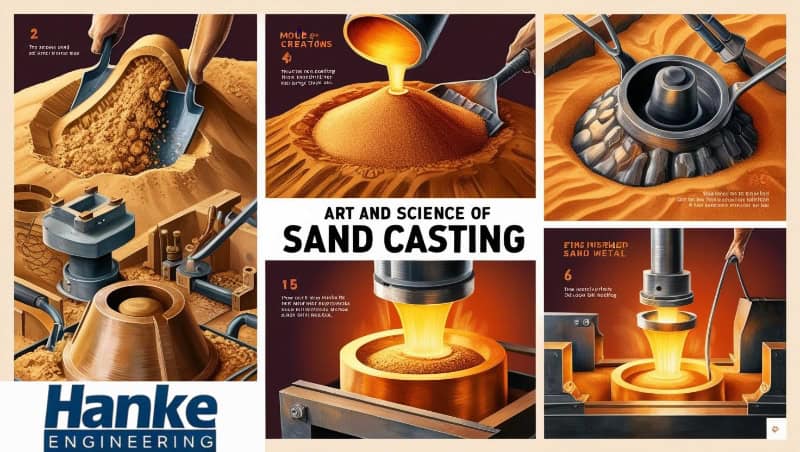The simplest and most standard metal casting process is sand casting. It serves as a measure of Ga-Unpo’s origin and testability. It then creates molds made of specially treated sand with a high melting point, but one that maintains the shape of the piece being cast.
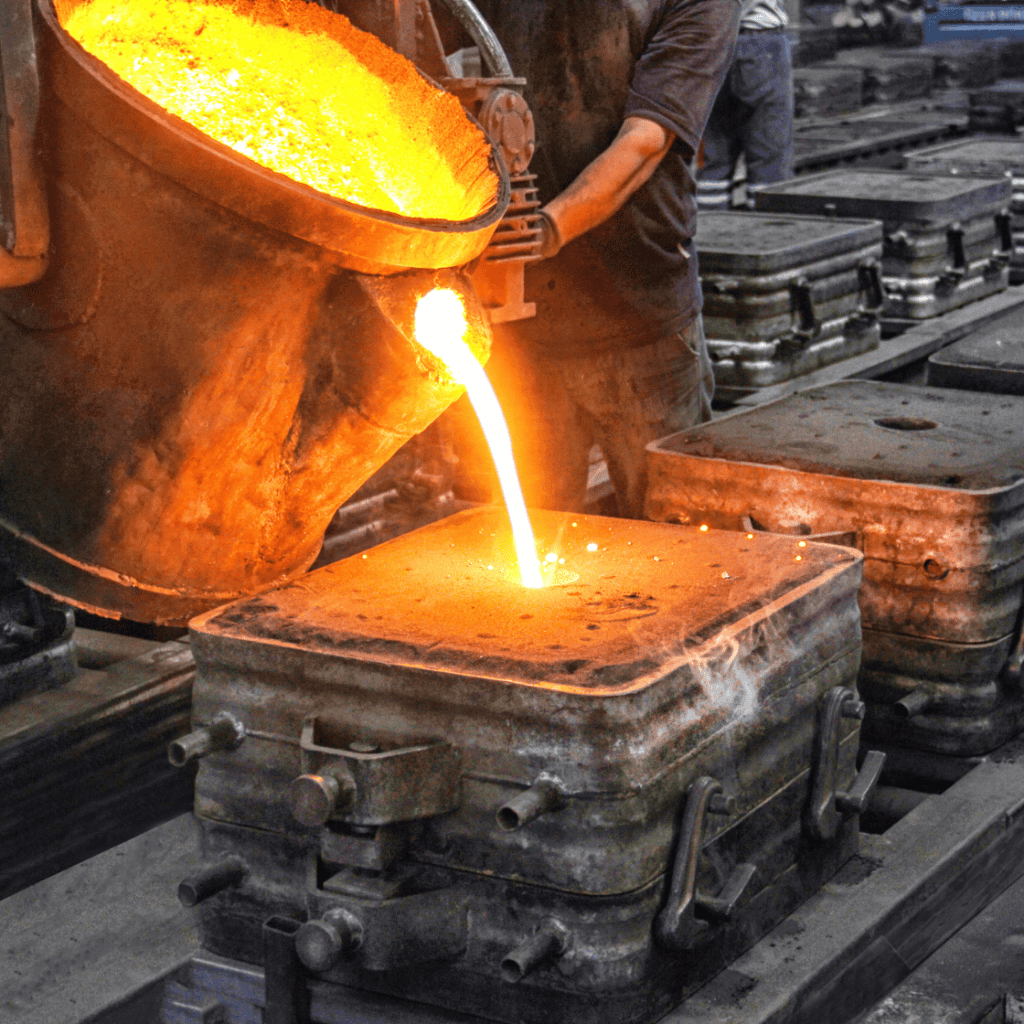
Alt Tag: Sand Casting
Casting moulds are generally used in automotive, aerospace and other heavy machinery industries to manufacture engine blocks, machine parts and other ornamental metals.
Sand casting is often picked for its harmony with aluminum, iron and brass, as well as other metals. That’s why its competitive price and flexibility recently made it a tool of choice for any kind of production, from small to big.
Importance in modern and traditional manufacturing
Sand casting, due to its low cost and universal applicability, is an essential element of modern and traditional production. It’s long been an ideal in traditional forms of production for this very reason — enabling artisans and industries to create complex metallic parts using limited equipment.
It can mutate a variety of metals and create iron-coated sculptures at will. It’s invaluable for making tool sets and artwork sculptures, and even savage industrial equipment. Its material economy and simplicity have allowed its use to transcend languages and cultures.
There’s no other industry more high-tech than sand casting; this technique has persisted as technology has grown and developed, but to create large and complex metal components, such as multiple automotive and aerospace components and heavy machinery applications.
Affordability, in turn, allows for a plethora of motorbans, pump lodgings, and machine parts. In recent years, New technologies enabling the development of raw materials for sand casting, such as molding materials or patterns, as well as automation, have contributed to improving precision and efficiency.
Sitting on top of this are up-and-coming technologies like investment casting and 3D printing, but the adaptability and inexpensive tooling polymerized by sand casting are both retainers of effective use for low- to medium-series applications.
What you need to know: Aluminum is a commonly used metal for sand casting.
Another very popular metal that is sand cast is aluminum. Aluminum is also lightweight, weather resistant, and has the highest strength-to-weight ratio. Since then, it has found use in various industrial operations, including those of automotive, aerospace, and construction industries, for producing engine parts, housings, and structural parts.
Casting Aluminium is very easy as well and hence used widely for any production, be it small or large; complex designs can be created with very little detail. Combined with its properties, aluminum’s recyclability and low cost make it an attractive option.
What is called Sand Casting?
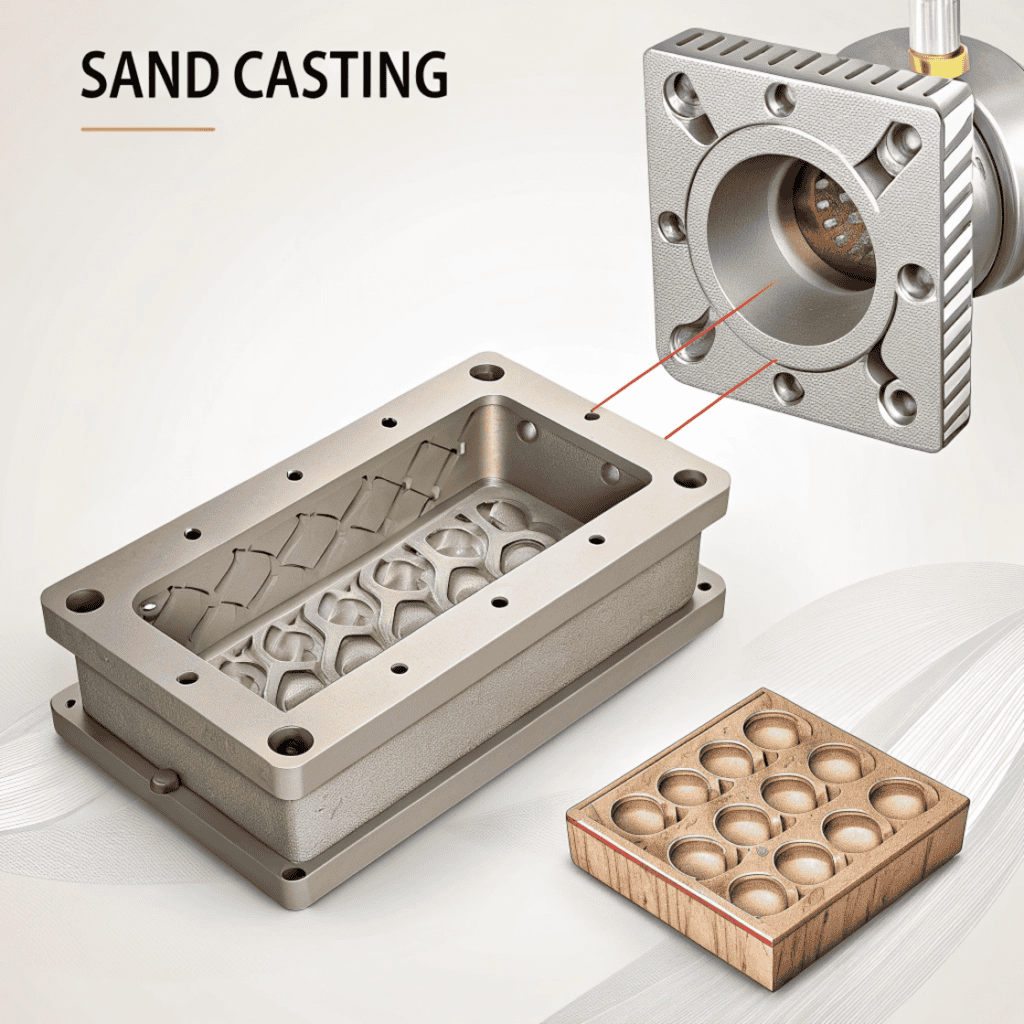
Alt Tag: What is called Sand Casting
Sand casting is a metal casting process that uses sand to be displayed as a mold material. It offers design freedom, is capable of making large and complex shapes and employs reusable, relatively cheap materials.
History and relevance of sand casting today
Sand casting has been used for thousands of years, far back as ancient Egypt and China, where it was used in creating devices, equipments, and decorative items. So this new technique drew on significant technical advances in the materials of the molds, their casting process, and the metal alloys they stimulated.
And thereby it concluded that cast iron became one of the most important ways to produce dispersal components in the Industrial Revolution. The sand casting process remains an important step in manufacturing because of its economical and versatile nature. It has the ability to produce complex metal components with different shapes and sizes.
It is widely used in the auto, aerospace, and heavy-duty machine industries to make engine blocks, pumps, many elements, and critical structures. However, to maintain its momentum in using industrial production, sand casting is gradually entering new markets, where advances in automation and materials science make it more efficient and accurate.
Comparison with other casting methods
Sand casting is among the most traditionally employed methods, although it is unique from other casting types in aspects of cost, precision, and utilisation characteristics. Due to the dimensional accuracy, investment casting with smoother finishes is generally the casting process used for the more intricate parts.
In contrast, sand casting is the process used for more extensive, complex pieces due to its lower costs. Then, while die casting offers you far higher precision and faster productivity, it comes at an important tooling cost. It means that sand casting is the method of production for low to medium runs, as well as more necessary components.
While sand casting offers versatility in terms of shape and size, permanent mold casting provides the advantage of producing stronger components with superior surface finishes due to the rapid cooling process.
Another alternative process, lost foam casting, eliminates the requirement of traditional cores and can create more sophisticated shapes, but is costly. The mentioned methods have their advantages and disadvantages in different industry applications.
Nonetheless, sand casting remains the primary method because of its cost-effectiveness, low-cost tooling and the ability to work with a wide range of metals.
How the Sand Casting Procedure Actually Works
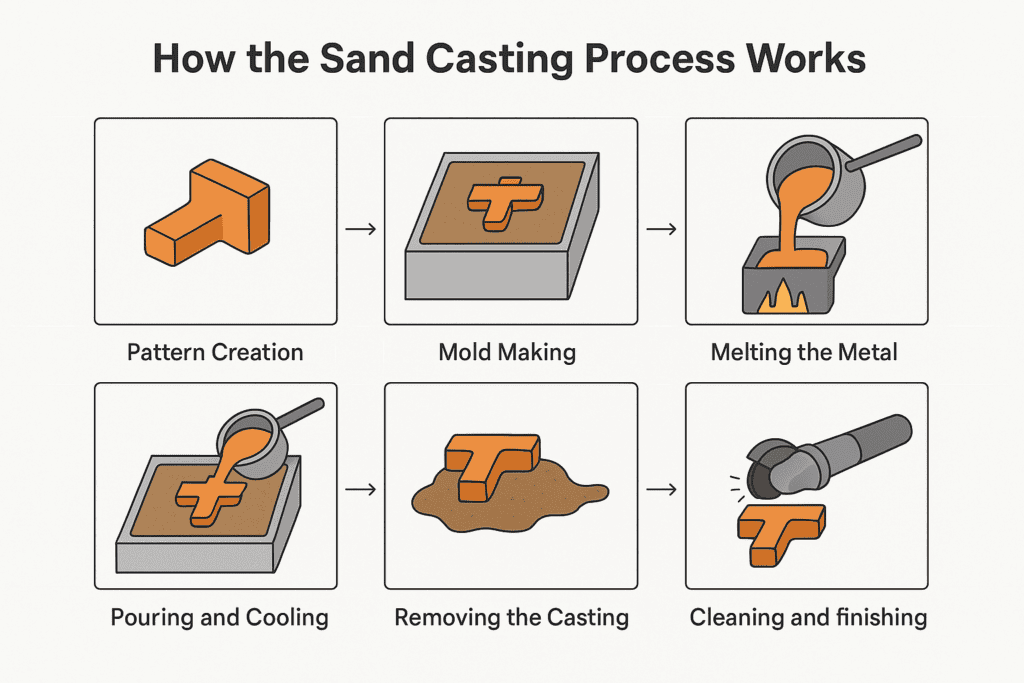
Alt Tag: Sand Casting Process
In the case of sand casting, first prepare the shape with a special type of sand. Once the shape is ready, you can pour the molten metal into the prepared mold. Then the metal is allowed to solidify, which will give the desired shape. It is a cost-effective and flexible method of adding it to the process of manufacturing, most widely used for the production of intricate metallic parts across a wide variety of industries.
Pattern creation
The sand casting process begins with the formation of a pattern. This pattern is then utilized to create the frame of sand. Hence, the mold casting acquires the given shape and a desired dimension.
Mold making
The mold-making involves filling up specially prepared sand around the depiction to establish a hollow pit of the design. A mold that is built of metal is filled with molten metal to make shapes. This process allows for precision casting production.
Melting the metal
The sand casting process begins with heating the selected metal, most commonly aluminum or iron, in a furnace until it takes liquid form. This process cleans up the molten metal for casting.
Pouring and cooling
During the pouring process, the molten metal is gushed into the sand frame with a hollow cavity. The poured metal is afterwards cooled and solidified. It then takes the shape of the frame, and produces the final cast component.
Removing the casting
The simplest method for removing the casting involves destroying the sand mold after the metal has cooled down completely. The cast component is detached from the mold, and then extra sand is wiped off. Thus, the product proceeds to finishing.
Cleaning and finishing
After getting the entire cast part, the sand should be washed off, all unnecessary parts should be removed, and the surface of the part should be finished. This process ensures that the results meet quality standards and are suitable for consumption or further processing.
Why Use Sand Casting? (Advantages & Limitations)
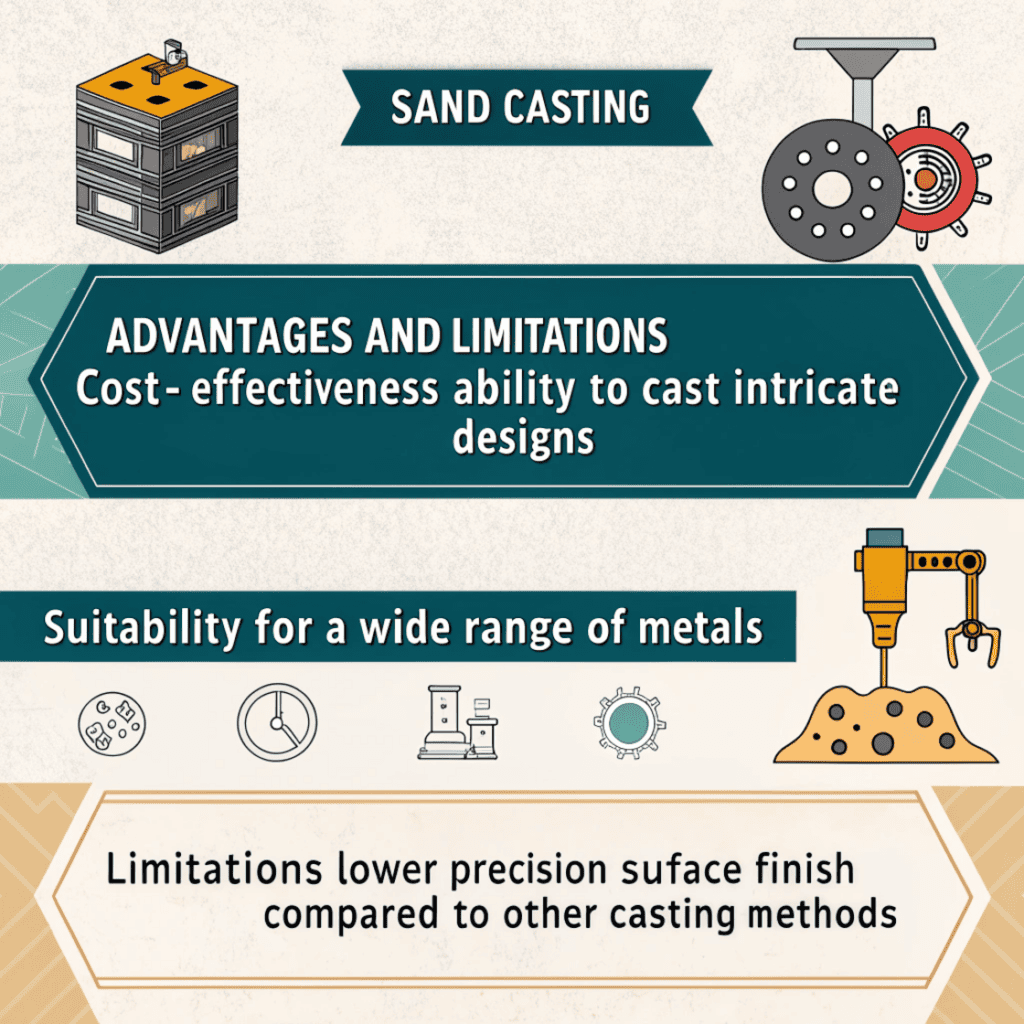
Alt Tag: Why Use Sand Casting
Sand casting is one of the most common and economical processes for manufacturing metal parts in a number of industries; it also has many disadvantages.
Advantages:
- Cost-Effective: It is an economical method for small to large-scale production runs with lower tooling costs.
- Versatile: Can produce complex shapes and significant components.
- Material Compatibility: Works for most metals like aluminum, iron, and brass.
- Recyclable Materials: These molds are generally used multiple times, so, they lead to minimum waste.
- Scalability: Perfect for low-volume and high-volume output.
Limitations:
- Surface Finish: More textured compared to Die or Investment Casting.
- Less Precise: The intricate details may require further machining
- Longer Cooling Process: Solidification may take longer than other casting techniques.
- Molding Wear: The sand molds can degrade with usage and must be regularly replaced.
Sand Cast Aluminum: Why Aluminum is Ideal for Sand Casting
The properties of C932 (C93200) together with the option of a variety of alloys give it one of the excellent choice metals for sand casting, as well as a range of uses.
Properties of Aluminum
Aluminium is an incredible sand casting metallic element because of its overview properties. Due to its lightweight nature, it can be used in lightweight components and parts to reduce the weight of the parts, which is significant in automotive and aerospace sectors.
Casting aluminum is also very resistant to corrosion, which saves it from rust and decay, even in severe environments. Its excellent thermal and electrical conductivity also makes it useful for industrial and electronic applications.
Common aluminum alloys used
The most used aluminum alloys in sand casting provide improvements in strength, longevity, and machinability. A356 alloy is one of the most commonly used aluminum alloys used to manufacture structural components, as it features relevant mechanical properties and corrosion resistance characteristics.
A typical example is 319 aluminum, which can be used in engine blocks and other automotive parts due to wear resistance. Marine use is typically made with 535 aluminum, which has high protection against corrosion.
Applications: automotive, aerospace, machinery
Their assessment then led to quantifying it back to that beloved shape of sand cast aluminum. In the automotive sector, for instance, it can be applied to engine components, transmission units, and wheels to make them more fuel-efficient and perform better.
The lightness of casting aluminum allows the use of smaller aircraft components without compromising on strength, allowing overall weight reduction, hence aluminum is another material extensively used in aerospace.
In fact, sand cast aluminum is also employed in industrial and commercial applications such as pumps, valves and heavy-duty equipment due to its durability and cost-effectiveness.
Sand Casting Examples
What is Metal Injection Molding (MIM)? Metal injection molding (MIM) is a standard process used to manufacture a large number of complex metal components across several industries.
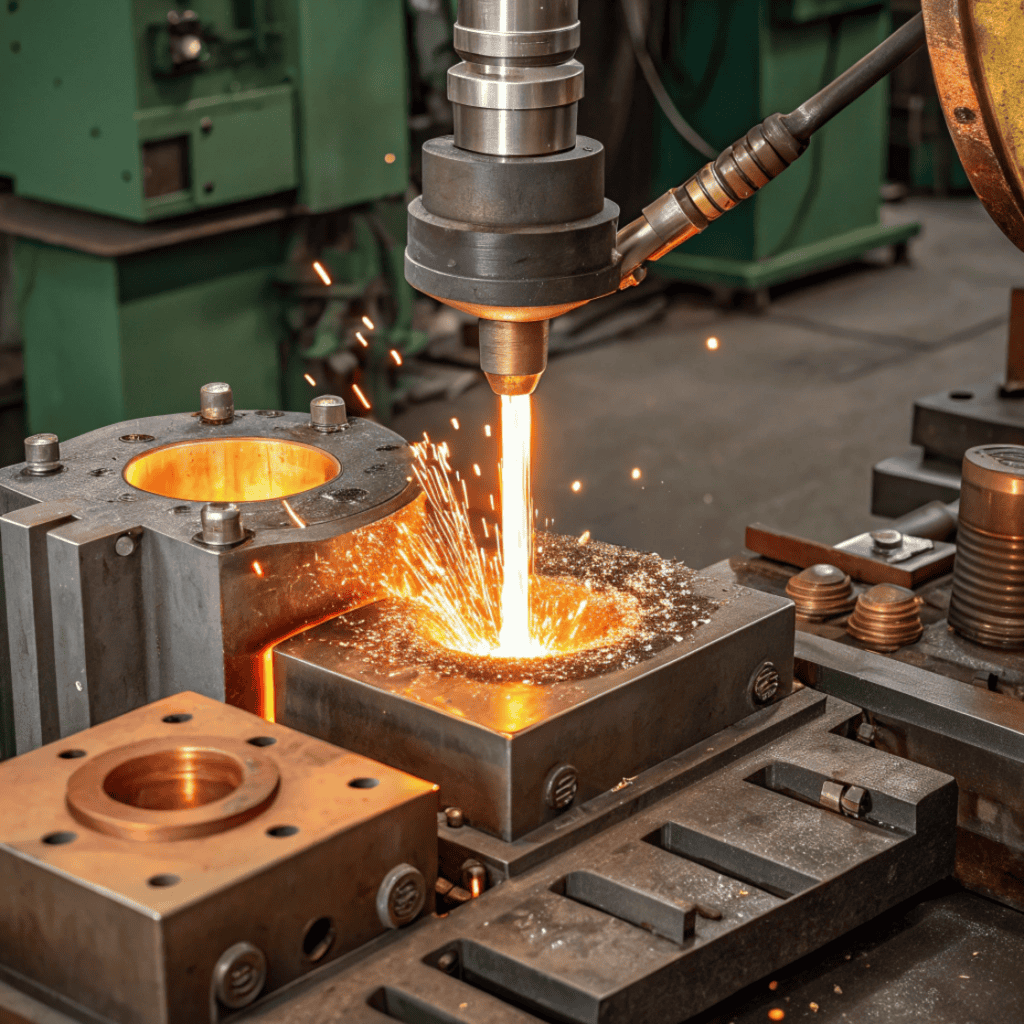
Alt Tag: Metal Injection Molding
It can range from small precision parts to massive pieces of industrial equipment, enabling manufacturers to produce a wide variety of goods. Here are some sand casting examples in genuine applications.
Real-world Sand Casting Examples Across Industries
Applications for Different Industries Automotive: The low cost of the sand casting process allows for engine blocks, cylinder heads, and transmission housings to be sand cast as they often require complex internal geometries.
Aerospace Industry – New sand casting methodologies make low-weight aluminum and magnesium elements added efficient, for key applications like aircraft brackets and structural components.
Industrial Machinery – Heavy Duty parts have to withstand the most severe conditions. Therefore, methods like sand casting are employed to manufacture large machine bases, pump housings, and valve bodies.
Art and Sculpture – Many artistic metal sculptures and decorative items are made using the sand casting process for unique designs and intricate details.
Construction & Infrastructure — Parts of heavy cast iron, like manhole covers, bases for streetlamps and bridges are manufactured using sand casting.
Automotive Industry Sand Casting Case Study
Background
A leading car manufacturing organisation needed a cost-effective method of producing complex engine blocks, which had high heat-resistant properties. The job was to build lightweight yet strong components that were also economical to produce.
Sand Casting
They opted for aluminum sand casting so they could achieve very complex designs, complete with internal cavities, but still be cost-effective. A356 aluminum alloy was chosen for its suitable strength-to-weight ratio, corrosion resistance, and machinability.
This involved using specialised molding methods to manufacture precision sand molds with tight dimensional tolerances and low defect rates.
Results & Impact
- Fuel Alternative – HLC ZL1 Engine Blocks – 30% Lighter
- Savings up to 25% as compared to other casting processes, such as die casting.
- Improved production scalability, allowing for mass production with minimal tooling costs.
- Advances in thermal properties increase performance and durability.
Final Thoughts about the Case Study
In so doing, it took advantage of the benefits of sand casting in reaction to the industry demand for light, resilient and low-cost engine parts. The case study highlights the relevance of sand casting in modern automotive engineering.
Showcase variety in scale and complexity
Casting aluminium can produce parts from small, intricate ones like a fancy gear to large, heavy ones, such as scale ship propellers or bases of machines. This process is essential in industries because it opens up a wide range of materials and the possibility to design.
Sand Casting vs. Other Casting Methods
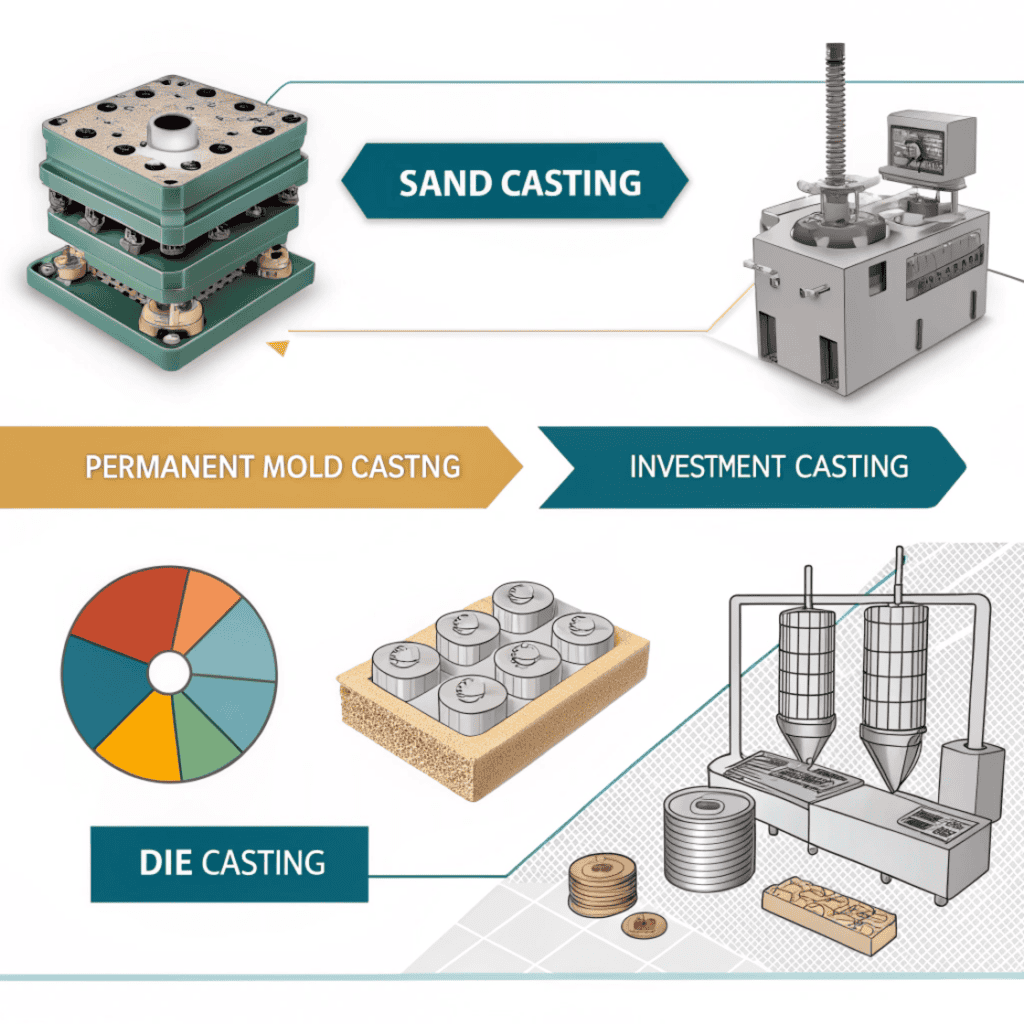
Alt Tag: Sand Casting vs. Other Casting Methods
Sand casting is a popular metal casting process widely used because of its low cost, flexibility, and ability to produce large, complex components. However, die casting, investment casting, and other casting methods provide many advantages like speed, spatial accuracy, and surface typography.
And knowing those differences helps manufacturers decide which method best fits their needs.
The Sand Casting Process – An Overview: Comparison with Other Methods
Die Casting – In this method, high-pressure molten metal is injected into a reusable frame. Best for mass production with strict precision, but an expensive tooling cost
Investment Casting – Requires making a wax model that is then covered with ceramic, after which the wax is melted out and metal poured. Creates complex details and smooth faces, but it is costly, and it can take hours to do.
Permanent Mold Casting – Uses a reusable mold like in die casting , but with gravity rather than pressure. It produces a superior surface finish to sand casting but has only limited shape complexity.
Lost Foam Casting — This method is like investment casting, but it make use of a foam model instead of wax model. It permits intricate shapes but needs specialized materials and processes.
Pros and Cons Comparison Table
| Casting Method | Benefits | Drawbacks |
| Sand Casting | Costs little, flexible, good for large parts | Rough surface finish, lower accuracy, extended cooling time |
| Die Casting | High precision, smooth surface finish, fast manufacturing | It costs lot of tooling, and not suitable for large components |
| Investment Casting | Low production cost, high-quality details, and minimal machining require | Costly, slow |
| Permanent Mold Casting | Reusable patterns, Good surface finish, Higher strength than sand castings | Returns business as usual, increase tooling cost |
| Lost Foam Casting | Complex shapes are possible with less machining required. | Needs costly patterns, higher setup cost |
Conclusion
Sand casting is a vital metal casting procedure widely used for industries to produce complex components with varying material properties and at low volumes.
When compared to other casting methods, such as die casting or investment casting, sand casting is preferred for its ability to manufacture both heavy and lightweight parts without the need for costly tooling.
This versatility across different metals, particularly aluminum, renders it an indispensable process in sectors like automotive, aerospace, and heavy machinery.
Sand casting is especially suited to aluminum because of its low mass, corrosion resistance, and a high strength-to-mass ratio. These systems enable manufacturers to manufacture durable and high-performing parts at the same time, affordably.
In either case, for blocks, structural parts, or industrial equipment, aluminum sand casting remains a preferred option for brands that want mass production without sacrificing quality.
Hanke Construction Machinery Manufacturing Co., Ltd. provides high-quality custom sand casting solutions. Specializing in precision sand casting for an assortment of industrial uses. You can choose the high-end, vast range of products from our featured a.
Get in touch today with your project requirements and see how we can help you realise your designs!
FAQs:
How is sand casting utilized?
The sand casting process is used to produce components in a variety of metals and several industries (such as automotive, aerospace, construction, industrial machinery). It is perfect for manufacturing engine blocks, pump housing, machine bases, valves, and decorative metalwork due to its low cost of producing complex shapes.
It is particularly suitable for high-volume production of large, weighty, and complex components in metals such as aluminum, iron, and brass.
Is sand casting suitable for aluminum?
Yes, aluminum is excellent for sand casting because it is light and highly resistant to corrosion, and it has a high strength-to-weight ratio. Because it melts quickly and is pourable, it is ideal for intricate and elaborate castings.
Casting aluminum is preferred by industries like automotive, aerospace, and industrial machinery owing to its cost-effectiveness, recyclability, and durability.
How does the sand casting process work?
Sand casting is a specific process with the following steps:
- Pattern Making – Create a wax, metal or plastic replica of the final piece to build the cavity of the mold.
- Make Molds – The design is filled with a particular type of sand to prepare the mold. Afterward, the frame is removed, creating a hollow pit.
- Core Placement (if applicable) – Cores are set into the mold in order to form internal voids in the finished casting.
- Melting the Metal – The metal, like aluminum or iron, is heated until it is fully melted.
- Pouring – The fully melted metal is then gushed into the sand mold hollow pit.
- Cooling and Solidification – The poured metal cools after sometime and it takes the form of the frame.
- Decasting – The sand mold is broken in the last to get the hardened metal.
- Cleaning and Finishing – Cleanliness is next to godliness; excess sand, gating, and rough edges are polished or machined as necessary.
This process enables robust, complex and economical parts to be manufactured throughout industries.


